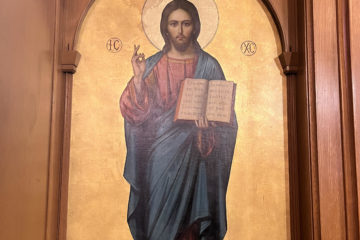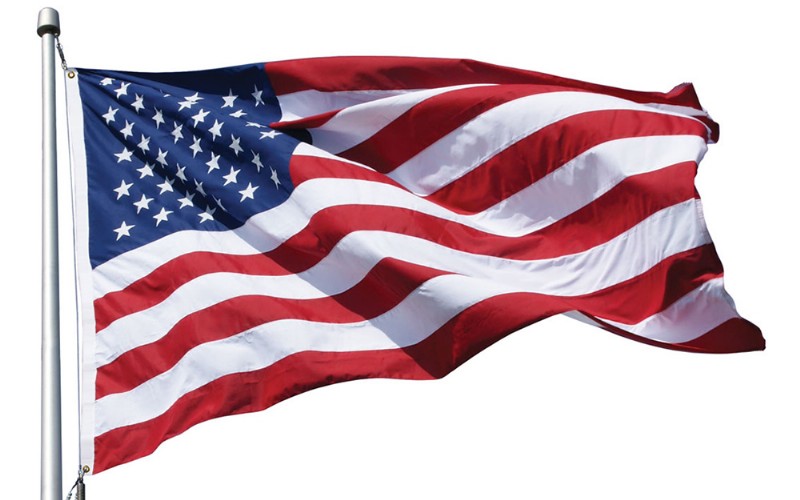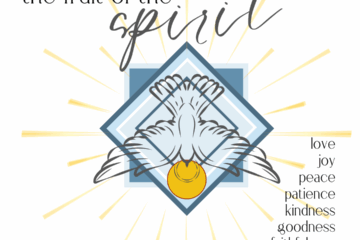The word “Orthros” means “arise.” The Orthros (or Matins) service is traditionally celebrated in the early morning hours because the end of the Orthros is a hymn (which is sung when a Divine Liturgy follows or read when it does not) called the Doxology, which begins with the words “Glory to You, who has shown us the light.” Traditionally this hymn was sung as the sun rises. In parish use, the Doxology precedes the Divine Liturgy so it generally takes place after sunrise, but still early in the day. For Holy Week, with the services moved up several hours, the Doxology takes place after the sun has set. Also, because the Divine Liturgy does not follow any of the evening services, the Doxology is read. On Good Friday night, there is an exception to this practice, and the Doxology is sung. More on that in a minute.
The Good Friday evening service is a beautiful service of transition from the heaviness of Holy Week to the anticipated joy of the Resurrection. There are changes in colors. Many priests wear red or gold for this service, leaving behind the dark purple and black vestments that have dominated the week. We sing all eight odes of the canon, rather than three. There are hymns called the “Evlogetaria”. On Saturdays, these are traditionally sung with reference to those who have passed away. (They are identical to hymns sung during the memorial service). On Sundays, they refer to the Resurrection. On this Holy Saturday (remember that the service on Friday evening is the Orthros for Holy Saturday), they are the hymns we sing on Sunday, for the Resurrection. Thus, the transition begins from Lent and Holy Week to the Resurrection and Paschal season, both visually, and in the hymnology. I can say as a priest, when I transition from the purple vestments to the white and red ones I wear on Good Friday, I feel lighter. As I put a red and white cloth on the altar, suddenly is feels bigger than when the purple one was on it. And as I battle the fatigue that my body and my voice feel by this time of the week, I feel recharged.
Back to the Doxology. This hymn reminds us of the Nativity, which was also a feast of transition. God’s voice has been silent for 350 years. There had been no prophet for 350 years. Meanwhile, abuses in the temple were the order of the day. A class of temple elites wielded power over the people. And the devout followers of God continued to pray for the day when the promised Messiah would come, not only to deliver them from religious oppression by their own leaders, but from political and military oppression suffered at the hands of the Romans.
When Christ was incarnate, a multitude of the heavenly host announced His birth, not to the thousands gathered in Bethlehem for the census, but to simple shepherds out in the countryside watching over their flocks. Imagine what it must have looked like, to see the entire sky lit up with the glory of all of God’s angels, and how beautiful their hymn must have sounded.
The Doxology is sung on Palm Sunday morning, preceding the Liturgy as it usually does. I still remember one of the priests I had growing up would have us turn up the lights fully at the Doxology, as if the church was coming alive for the special event of the Divine Liturgy which was about to begin. No, the Doxology is not part of the Divine Liturgy, but it was like the announcement that the Divine Liturgy was about to begin. On Good Friday night, after the week of long and somber services, the Doxology serves (in my opinion anyway) as the announcement that the Resurrection is about to happen. The main event of human history is about to be relived again.
This hymn is filled with praise, supplication and teaching. Many of our hymns contain only one of these three elements. God is glorified. The Trinity is revealed. Christ is recognized as the “Lamb of God, Son of the Father.” In this hymn, we ask multiple times for mercy and healing. And we are reminded that God is “our refuge from generation to generation.”
It is at the end of the Doxology that the Epitaphios (inside the Kouvoukion and in some cases, by itself) is carried around the church (either inside or outside) in procession. It is also customary for the faithful to pass under the Epitaphios in what I have always thought is a beautiful rehearsal for the day that we will pass through death to eternal life. It anticipates our own transition from this life to everlasting life.
The Doxology is the “announcement” of transition. When it precedes Divine Liturgy, it is a reminder that we the faithful are about to transition out of our lives temporarily to enter into God’s Kingdom, which is present at the Divine Liturgy. On Christmas, it was the announcement to the world, through the eyes of the Shepherds, that God’s promised Messiah was entering the world. On Good Friday, it is an announcement for us that our celebration of the Resurrection is about to commence after the long journey of Lent and Holy Week. And during the procession that follows, walking under the Epitaphios is a reminder that one day we will transition from the life we know to another life—with the prayer that this will be not eternal punishment for those who do not know God, but eternal blessedness for those who do.
As a personal aside, Good Friday remains one of the most popular services of Holy Week. And certainly it is important because it is the bridge between the Passion and the Resurrection. It is critically important, however, that we experience the services on both sides of this bridge. It is critically important that we experience the crucifixion of Christ so that we have first experienced sorrow and sadness before we begin a transition to joy.
Glory to You, who has shown us the Light. Glory to God in the highest, and on earth peace, good will to all people. We praise You, we bless You, we worship You, we glorify You, we thank You, for Your great glory. Lord, King, Heavenly God, Father Almighty; Lord, only-begotten Son, Jesus Christ and Holy Spirit. Lord, God, the Lamb of God, Son of the Father, Who takes away the sin of the world; have mercy on us, You Who takes away the sins of the world. Accept our prayer, You, Who are seated on the right hand of the Father, and have mercy on us. For You alone are Holy; You alone are Lord, Jesus Christ, to the glory of God, the Father. Amen. Each day I shall bless You, and shall praise Your Name forever, and to the age of the age. Grant O Lord that this day we may be kept without sin. Blessed are You, O Lord, God of our Father, and praised and glorified is Your Name to all ages. Amen. Lord, let Your mercy come upon us, as we have hoped in You. Blessed are You O Lord, teach me Your statutes. (3) Lord, You have been our refuge from generation to generation. I said: “Lord, have mercy on me; heal my soul, for I have sinned against You.” Lord, to You I have fled; teach me to do Your will, for You are my God. For in You is the fountain of Life, and in Your Light we shall see light. Extend Your mercy to those who know You. Holy God, Holy Mighty, Holy Immortal, have mercy on us. (3) Glory to the Father and to the Son and to the Holy Spirit, Now and ever and to the ages of ages. Amen. Holy Immortal have mercy on us. Holy God, Holy Mighty, Holy Immortal, have mercy on us. (Doxology, Lamentations, Good Friday evening, Trans. by Fr. George Papadeas)
The singing of the Doxology always announces that something special is about to happen. And that is most certainly true as we sing it on Good Friday evening.



0 Comments